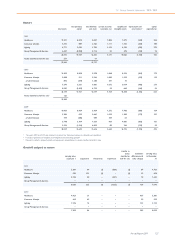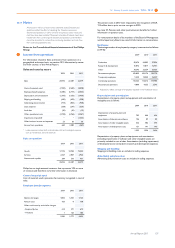Philips 2011 Annual Report Download - page 129
Download and view the complete annual report
Please find page 129 of the 2011 Philips annual report below. You can navigate through the pages in the report by either clicking on the pages listed below, or by using the keyword search tool below to find specific information within the annual report.
12 Group financial statements 12.10 - 12.10
Annual Report 2011 129
12.10 Significant accounting policies
The Consolidated financial statements have been prepared in
accordance with International Financial Reporting Standards (IFRS) as
endorsed by the European Union (EU). All standards and
interpretations issued by the International Accounting Standards Board
(IASB) and the IFRS Interpretations Committee effective year-end 2011
have been endorsed by the EU, except that the EU did not adopt some
paragraphs of IAS 39 applicable to certain hedge transactions. Philips
has no hedge transactions to which these paragraphs are applicable.
Consequently, the accounting policies applied by Philips also comply
fully with IFRS as issued by the IASB. These accounting policies have
been applied by group entities.
Certain comparative amounts in the Statement of income have been
reclassified to conform to the current year’s presentation. In addition,
the comparative Statement of income and statements of cash-flows
have been represented as if an operation discontinued during the
current year had been discontinued from the start of the comparative
years (See note 5, Discontinued operations and other assets classified
as held for sale and section 12.4, Consolidated statements of income,
of this Annual Report, section 12.7, Consolidated statements of cash
flows, of this Annual Report and section 12.9, Information by sector
and main country, of this Annual Report).
The Consolidated financial statements have been prepared under the
historical cost convention, unless otherwise indicated.
The Consolidated financial statements are presented in euros, which is
the Company’s presentation currency.
On February 23, 2012, the Board of Management authorized the
Consolidated financial statements for issue. The Consolidated financial
statements as presented in this report are subject to the adoption by
the Annual General Meeting of Shareholders.
Use of estimates
The preparation of the Consolidated financial statements in conformity
with IFRS requires management to make judgments, estimates and
assumptions that affect the application of accounting policies and the
reported amounts of assets, liabilities, income and expenses.
These estimates and assumptions affect the reported amounts of assets
and liabilities, the disclosure of contingent liabilities at the date of the
Consolidated financial statements, and the reported amounts of
revenues and expenses during the reporting period. We evaluate these
estimates and judgments on an ongoing basis and base our estimates
on experience, current and expected future conditions, third-party
evaluations and various other assumptions that we believe are
reasonable under the circumstances. The results of these estimates
form the basis for making judgments about the carrying values of assets
and liabilities as well as identifying and assessing the accounting
treatment with respect to commitments and contingencies. Actual
results may differ from these estimates.
Estimates significantly impact goodwill and other intangibles acquired,
tax on activities disposed, impairments, financial instruments, the
accounting for an arrangement containing a lease, revenue recognition
(multiple element arrangements), assets and liabilities from employee
benefit plans, other provisions and tax and other contingencies,
classification of assets and liabilities held for sale and the presentation
of items of profit and loss and cash-flows as continued or discontinued.
The fair values of acquired identifiable intangibles are based on an
assessment of future cash flows. Impairment analyses of goodwill and
indefinite-life intangible assets are performed annually and whenever a
triggering event has occurred to determine whether the carrying value
exceeds the recoverable amount. These analyses generally are based
on estimates of future cash flows.
The fair value of financial instruments that are not traded in an active
market is determined by using valuation techniques. The Company uses
its judgment to select from a variety of common valuation methods
including the discounted cash flow method and option valuation models
and to make assumptions that are mainly based on market conditions
existing at each balance sheet date.
Actuarial assumptions are established to anticipate future events and
are used in calculating pension and other postretirement benefit
expense and liability. These factors include assumptions with respect
to interest rates, expected investment returns on plan assets, rates of
increase in health care costs, rates of future compensation increases,
turnover rates, and life expectancy.
Basis of consolidation
The Consolidated financial statements include the accounts of
Koninklijke Philips Electronics N.V. (‘the Company’) and all subsidiaries
that fall under its power to govern the financial and operating policies
of an entity so as to obtain benefits from its activities. The existence
and effect of potential voting rights that are currently exercisable are
considered when assessing whether the Company controls another
entity. Subsidiaries are fully consolidated from the date that control
commences until the date that control ceases. All intercompany
balances and transactions have been eliminated in the Consolidated
financial statements. Unrealized losses are eliminated in the same way
as unrealized gains, but only to the extent that there is no evidence of
impairment.
Business combinations
Business combinations are accounted for using the acquisition method.
Under the acquisition method, the identifiable assets acquired, liabilities
assumed and any non-controlling interest in the acquiree are
recognized as at the acquisition date, which is the date on which control
is transferred to the Company. Control is the power to govern the
financial and operating policies of an entity so as to obtain benefits from
its activities. In assessing control, the Company takes into consideration
potential voting rights that currently are exercisable.
For acquisitions on or after January 1, 2010, the Company measures
goodwill at the acquisition date as:
• the fair value of the consideration transferred; plus
• the recognized amount of any non-controlling interest in the
acquiree;
• plus if the business combination is achieved in stages, the fair value
of the existing equity interest in the acquiree;
• less the net recognized amount (generally fair value) of the
identifiable assets acquired and liabilities assumed.
When the excess is negative, a bargain purchase gain is recognized
immediately in profit or loss (hereafter referred to as the Statement of
income).
The consideration transferred does not include amounts related to the
settlement of pre-existing relationships. Such amounts are generally
recognized in the Statement of income.
Costs related to the acquisition, other than those associated with the
issue of debt or equity securities, that the Company incurs in
connection with a business combination are expensed as incurred.
Acquisitions between January 1, 2004 and January 1, 2010
For acquisitions between January 1, 2004 and January 1, 2010, goodwill
represents the excess of the cost of the acquisition over the Company’s
interest in the recognized amount (generally fair value) of the
identifiable assets, liabilities and contingent liabilities of the acquiree.
Transaction costs, other than those associated with the issue of debt
or equity securities, that the Company incurred in connection with
business combinations were capitalized as part of the cost of the
acquisition.
Acquisitions of Non-controlling interests
Acquisitions of non-controlling interests are accounted for as
transactions with owners in their capacity as owners and therefore no
goodwill is recognized as a result. Adjustments to non-controlling
interests arising from transactions that do not involve the loss of
control are based on a proportionate amount of the net assets of the
subsidiary.
For changes to non-controlling interest without the loss of control, the
difference between such change and any consideration paid or received
is recognized directly in equity.
Loss of control
Upon the loss of control, the Company derecognizes the assets and
liabilities of the subsidiary, any non-controlling interests and the other
components of equity related to the subsidiary. Any surplus or deficit
arising on the loss of control is recognized in profit or loss. If the
Company retains any interest in the previous subsidiary, then such
























